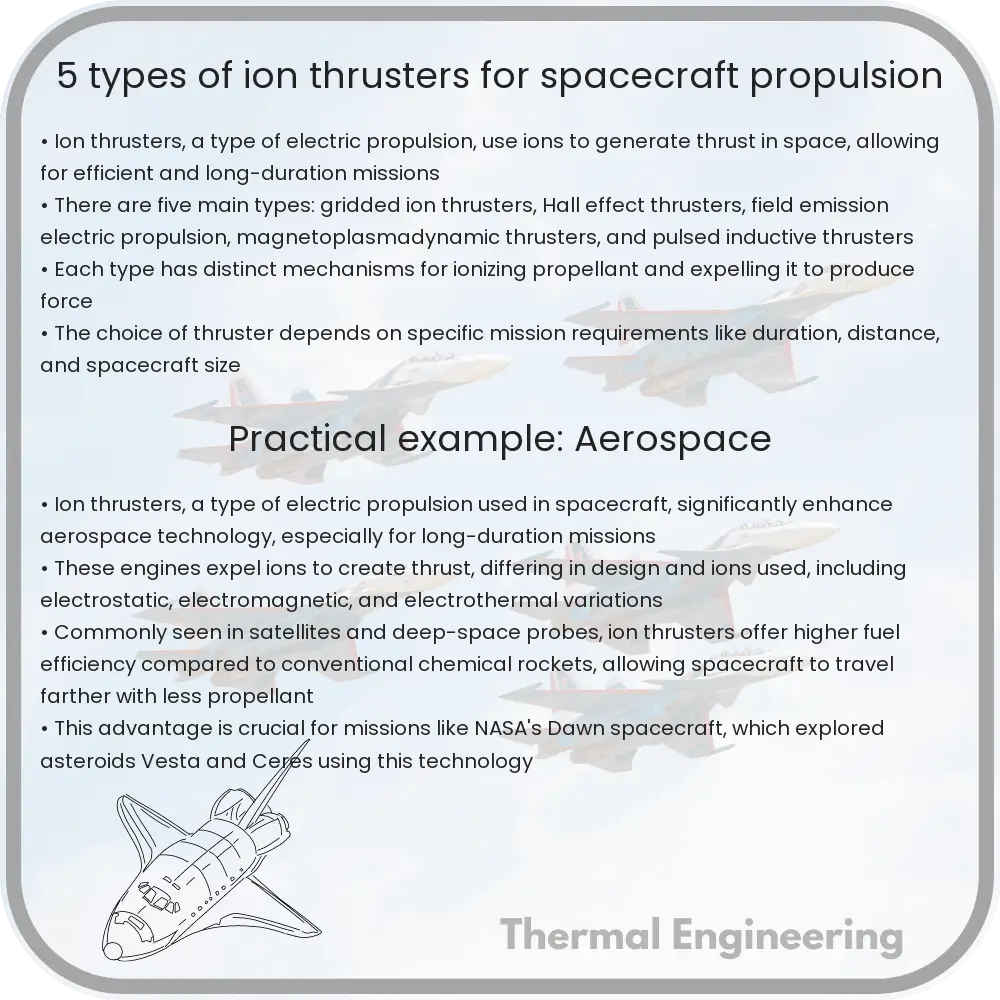Learn about ion thrusters, advanced space propulsion systems using electric fields to ionize and accelerate propellants, enhancing fuel efficiency for long missions.

Introduction to Ion Thrusters
Ion thrusters represent a revolutionary shift in propulsion technology for space exploration. Unlike conventional chemical rockets that burn fuel, ion thrusters use electricity to ionize a propellant like xenon, producing charged particles. These ions are then accelerated by electric fields to create thrust. The result is a highly efficient, albeit low-thrust, engine perfect for long-duration missions in outer space where fuel economy is critical.
Types of Ion Thrusters
Several types of ion thrusters have been developed, each incorporating unique mechanisms to generate and utilize ions for propulsion. Here, we explore five significant types:
- Electrostatic Ion Thrusters
- Electromagnetic Ion Thrusters
- Electrothermal Ion Thrusters
- Field Emission Electric Propulsion (FEEP)
- Colloid Ion Thrusters
1. Electrostatic Ion Thrusters
Electrostatic ion thrusters, also known as gridded ion thrusters, are the most common type. They work by ionizing a noble gas (usually xenon) and using a series of grids with high voltage to accelerate the ions. The thrust is generated as the ions are expelled at high velocities, up to 90,000 m/s. The NASA Dawn spacecraft utilized this technology to explore Vesta and Ceres in the asteroid belt.
2. Electromagnetic Ion Thrusters
Also known as Hall Effect Thrusters (HET), these devices leverage an electromagnetic field to ionize propellant and accelerate ions. A magnetic field perpendicular to the electric field traps electrons, which then collide with the propellant atoms to ionize them. The ions are then pushed out by the electric field, creating thrust. Hall thrusters are known for their relatively high thrust efficiency and have been used in various satellites and interplanetary missions.
3. Electrothermal Ion Thrusters
Electrothermal thrusters, such as the Resistojet, operate by electrically heating the propellant to increase its thermal energy, thus creating higher exhaust velocities when expelled through a nozzle. While not strictly ion thrusters as the others, they are sometimes grouped under the same category due to their use of electrical power and similar applications in space propulsion.
4. Field Emission Electric Propulsion (FEEP)
FEEP thrusters are a form of micro-propulsion that utilizes the field emission properties of liquid metal (typically cesium or indium) to generate ions. A high electric field at a sharp emitter tip induces ionization and field emission, producing a pure ion beam for propulsion. Due to their ability to provide very precise thrust levels, FEEPs are ideal for small satellite attitude control and formation flying.
5. Colloid Ion Thrusters
Colloid thrusters use a colloidal solution (typically a suspension of charged nanoscale particles) expelled through an emitter. By applying a high voltage, these particles are ionized and accelerated, providing thrust. Similar to FEEP, colloid thrusters offer highly fine control of thrust and are primarily used for precise maneuvering of small spacecraft.
Conclusion
Ion thrusters are a cornerstone of modern spacecraft propulsion, offering longer mission durations and reduced fuel needs compared to traditional rocket technology. With the variety of types available, scientists and engineers can select a propulsion system best suited to a specific mission’s requirements, paving the way for more ambitious exploration of our solar system and beyond.